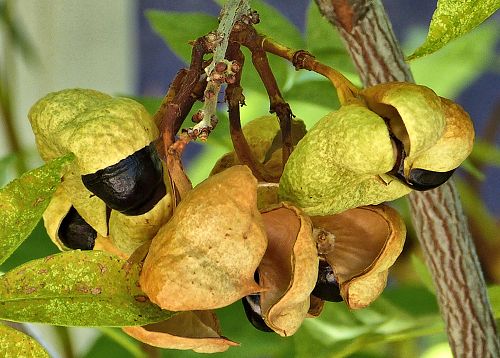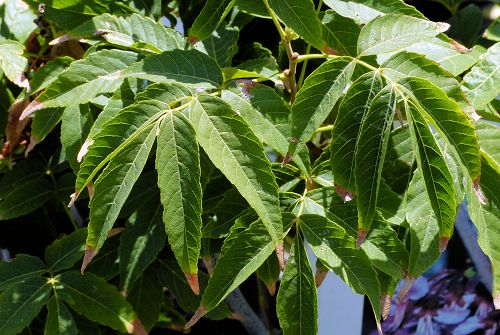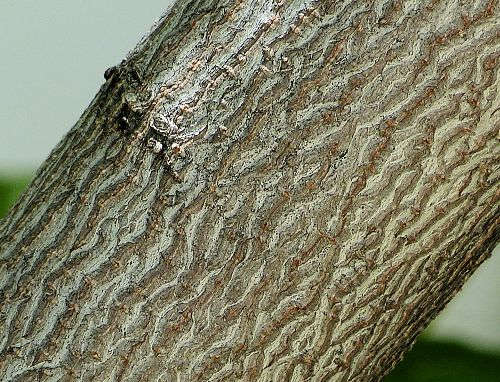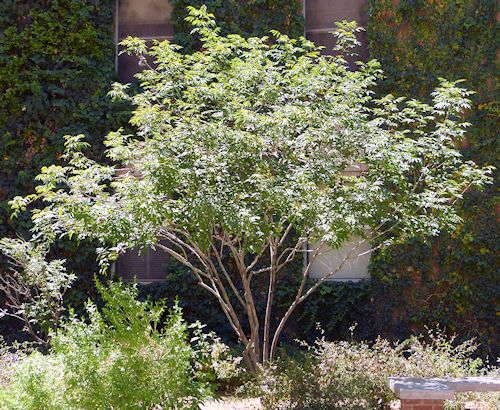Growing Ungnadia speciosa:
Mexican Buckeye
Back to Trees and Palms
Description
Form: A multi-trunked shrub, or with pruning, a tree.
Leaf retention: Deciduous.
Growth rate: Slow the first year, increasing with age, dependent on water and sun.
Mature Size: Typically 10-15' (3-4.5m) high and wide, but up to 30' (9m) in favorable locations.
Flowers: Rose-purple to pink, four petals, 7-10 long stamens, one style, fragrant.
Bloom: Late winter to late spring, just before or during leaf-out. Flowers for the entire tree are in bloom for only one or two weeks.
Fruit: A three chambered seed pod containing shiny, sweet but poisonous, dark round seeds, about 1/2" (12mm) in diameter, persisting on the tree for most of the year.
Leaves: Green, oval to lance-shaped leaflets, poisonous, turning yellow in fall. This plant provides dense shade.
Stems: Smooth, mottled, gray-brown bark, no thorns.
Roots: A deep taproot. This plant can resprout from its roots if cut down after becoming well established. It is not invasive.
Wildlife: The flowers attract bees and butterflies. This tree is a larval host to some butterfly species. The seed attracts insects and small mammals.
Toxic / Danger: The sweet-tasting seeds are poisonous. The leaves are poisonous to livestock but are seldom browsed.
Origin: New Mexico, Texas, and Mexico.
Form: A multi-trunked shrub, or with pruning, a tree.
Leaf retention: Deciduous.
Growth rate: Slow the first year, increasing with age, dependent on water and sun.
Mature Size: Typically 10-15' (3-4.5m) high and wide, but up to 30' (9m) in favorable locations.
Flowers: Rose-purple to pink, four petals, 7-10 long stamens, one style, fragrant.
Bloom: Late winter to late spring, just before or during leaf-out. Flowers for the entire tree are in bloom for only one or two weeks.
Fruit: A three chambered seed pod containing shiny, sweet but poisonous, dark round seeds, about 1/2" (12mm) in diameter, persisting on the tree for most of the year.
Leaves: Green, oval to lance-shaped leaflets, poisonous, turning yellow in fall. This plant provides dense shade.
Stems: Smooth, mottled, gray-brown bark, no thorns.
Roots: A deep taproot. This plant can resprout from its roots if cut down after becoming well established. It is not invasive.
Wildlife: The flowers attract bees and butterflies. This tree is a larval host to some butterfly species. The seed attracts insects and small mammals.
Toxic / Danger: The sweet-tasting seeds are poisonous. The leaves are poisonous to livestock but are seldom browsed.
Origin: New Mexico, Texas, and Mexico.
Cultivation and Uses
USDA hardiness zones: 7-11.
Heat tolerant: Yes.
Drought tolerant: Yes.
Sun: Full sun to part shade.
Soil: Well draining, dry, low in organic content, pH 6.1-8.5 (slightly acidic to alkaline).
Water after becoming established: Once or twice a month.
Prune: After flowering, prune to develop a tree form or to maintain a rounded shape. Flowers bloom on old wood.
Litter: Flowers and seeds.
Propagation: Fresh seeds planted in moist, very warm soil often sprout in 2-3 weeks. Do not allow the soil to dry out.
Uses: Ornamental, hedge, low water (xeriscape) garden.
USDA hardiness zones: 7-11.
Heat tolerant: Yes.
Drought tolerant: Yes.
Sun: Full sun to part shade.
Soil: Well draining, dry, low in organic content, pH 6.1-8.5 (slightly acidic to alkaline).
Water after becoming established: Once or twice a month.
Prune: After flowering, prune to develop a tree form or to maintain a rounded shape. Flowers bloom on old wood.
Litter: Flowers and seeds.
Propagation: Fresh seeds planted in moist, very warm soil often sprout in 2-3 weeks. Do not allow the soil to dry out.
Uses: Ornamental, hedge, low water (xeriscape) garden.
Comments
Ungnadia speciosa is a member of the Soapberry family (Sapindaceae), but is not a true Buckeye, which belong to the genus Aesculus within the same family. The seed pods resemble those of the Buckeye tree, giving the plant its common name.
Do you have additional information or a different experience for these plants that you would like to share? Email info@GardenOracle.com. All contributions are welcome and appreciated.
Ungnadia speciosa is a member of the Soapberry family (Sapindaceae), but is not a true Buckeye, which belong to the genus Aesculus within the same family. The seed pods resemble those of the Buckeye tree, giving the plant its common name.
Do you have additional information or a different experience for these plants that you would like to share? Email info@GardenOracle.com. All contributions are welcome and appreciated.






Latest update: October, 2024
© 2008-2025 by GardenOracle.com

